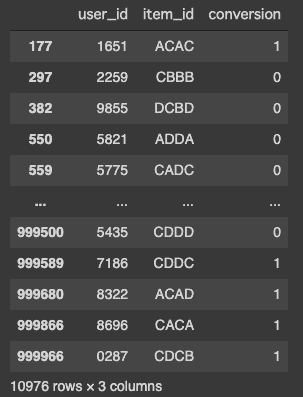Meet Pandas: Group-wise Sampling
October 13, 2020 | 2 min read
🐼Welcome back to the “Meet Pandas” series (a.k.a. my memorandum for learning Pandas)!🐼
Last time, I discussed DataFrame’s easy-to-read selecting method called query.
Today, I introduce how to sample groups, or group-wise split a dataset. This may help you when you want to avoid data leakage.
Create Example Data
Suppose we are developing a user-to-item recommender model and have a dataset of 1,000,000 user-item interactions, which include 10,000 unique users, 256 items, and the corresponding conversion flag. Let’s synthesize this dataset with itertools:
from itertools import product
import numpy as np
import pandas as pd
str_numbers = "".join(map(str, range(10)))
# ['0000', '0001', ..., '9999']
user_ids = list(map("".join, product(str_numbers, repeat=4)))
# ['AAAA', 'AAAB', ..., 'DDDD']
item_ids = list(map("".join, product("ABCD", repeat=4)))
num_records = 10**6
df = pd.DataFrame({'user_id': np.random.choice(user_ids, num_records),
'item_id': np.random.choice(item_ids, num_records),
'conversion': np.random.choice([0, 1], num_records)})
dfThe dataframe should look something like this:
Random Sampling Leads to Data Leakage
This might be too bulky to handle, and you might feel like downsampling when you train a model as such:
df.groupby('user_id').sample(frac=0.01)But, in this case, random split leads to data leakage because this dataset includes multiple (100 on average) records for each user. To avoid this, we should use group-wise splitting. But how?
Group-wise Sampling
Again, this dataset contains 10,000 unique users.
df["user_id"].nunique()
# >> 10000Let’s say we are sampling 100 users to obtain a set of approximately 10,000 records. This is achieved by chaining groupby and filter.
df_sampled = df.query('user_id in @').filter(lambda _: np.random.rand() < 0.01)
df_sampled["user_id"].nunique()
# >> 107This solution isn’t bad, but it doesn’t assure that the sampled set includes exactly 100 users. This can be a problem when the number of users is small. If you want to sample exactly 100 users, you should explicitly do that before filtering.
sampled_users = np.random.choice(df["user_id"].unique(), 100)
df_sampled = df.groupby('user_id').filter(lambda x: x["user_id"].values[0] in sampled_users)
df_sampled["user_id"].nunique()
# >> 100
# Wall time: 1.8 sThis solution always returns a sampled dataset of 100 users! But, there is still room for improvement. The following code is 10 times faster and produces exactly the same result.
sampled_users = np.random.choice(df["user_id"].unique(), 100)
df_sampled = df.query('user_id in @sampled_users')
df_sampled["user_id"].nunique()
# >> 100
# Wall time: 117 msIf you are not familiar with the method query, take a look at my last post on Pandas.
References
[1] Group by: split-apply-combine — pandas 1.1.3 documentation
[2] itertools — Functions creating iterators for efficient looping — Python 3.9.0 documentation
![[object Object]](/static/2d0f4e01d6e61412b3e92139e5695299/e9fba/profile-pic.png)
Written by Shion Honda. If you like this, please share!












